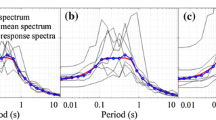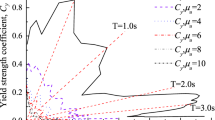Abstract
To consider the influence of aftershocks in engineering design, the correlations between main shocks and aftershocks should be examined, and an aftershock simulation method with main shock ground motions needs to be developed. In this study, the data on the sequences of main shock-aftershock ground motions and other related parameters were collected. Using these data, correlations between the magnitude, frequency, duration and energy of the main shock-aftershock ground motions were investigated. The results showed that the magnitude of the aftershock can be larger than that of the main shock. The shapes of the Fourier amplitude spectra of main shocks and aftershocks were similar; however, the predominant frequency and high-frequency components of the aftershock tended to be larger. Considering the magnitude difference between the main shock and the aftershock, the correlation of durations was explored. Additionally, a new concept, the duration ratio, was defined to describe the concentration of seismic energy release, and main shock energy was strongly positively correlated with the energy attenuated during the main shock-aftershock sequence. Finally, based on these results regarding correlation, an aftershock synthesis using recorded main shock ground motions was constructed with the trigonometric series method for seismic design, and some examples are given to analyze the rationality of this synthetic method.
Similar content being viewed by others
References
Allamehzadeh M, Dezvareh M, Farahbod AM, Hatzfeld D, Mokhtari M, Moradi AS, Mostafazadeh M, Paul A and Tatar M (2005), “Seismological Aspects of the 2003 Bam, Iran, Earthquake and Its Aftershock Analysis,” Earthquake Spectra, 21(S1): S101–S112.
Baltay A and Hanks TC (2013), “Understanding the Magnitude Dependence of PGA and PGV: A Look at Differences Between Main Shocks and Aftershocks in the NGA-West2 Data and Ground Motion from Small Magnitude Anza Data,” AGU Fall Meeting, AGU Fall Meeting Abstracts.
Bani-Hani KA and Malkawi AI (2017), “A Multi-Step Approach to Generate Response-Spectrum- Compatible Artificial Earthquake Accelerograms,” Earthquake Spectra, 97: 117–132.
Campbell KW and Bozorgnia Y (2012), “A Comparison of Ground Motion Prediction Equations for Arias Intensity and Cumulative Absolute Velocity Developed Using a Consistent Database and Functional Form,” Earthquake Spectra, 28(3): 931–941.
Chen XW, Li HN, Wang DS and Li C (2015), “Life-Cycle Seismic Performance Analysis of Offshore RC Bridge Piers under Mainshock and Aftershock,” Earthquake Engineering and Engineering Vibration, 35(4): 145–154. (in Chinese)
Das S and Gupta VK (2008), “Wavelet-based Simulation of Spectrum-compatible Aftershock Accelerograms,” Earthquake Engineering and Structural Dynamics, 37(11): 1333–1348.
Das S and Gupta VK (2010), “Scaling of Response Spectrum and Duration for Aftershocks,” Soil Dynamics and Earthquake Engineering, 30(8): 724–735.
Das S, Gupta VK and Srimahavishnu V (2007), “Damage-Based Design with no Repairs for Multiple Events and Its Sensitivity to Seismicity Model,” Earthquake Engineering and Structural Dynamics, 36(3): 307–325.
Goda K and Taylor CA (2012), “Effects of Aftershocks on Peak Ductility Demand due to Strong Ground Motion Records from Shallow Crustal Earthquakes,” Earthquake Engineering and Structural Dynamics, 41(15): 2311–2330.
Hatzigeorgiou GD and Beskos DE (2009), “Inelastic Displacement Ratios for SDOF Structures Subjected to Repeated Earthquakes,” Engineering Structures, 31(11): 2744–2755.
Hosseinpour F and Abdelnaby AE (2017), “Effect of Different Aspects of Multiple Earthquakes on the Nonlinear Behavior of RC Structures,” Soil Dynamics and Earthquake Engineering, 92: 706–725.
Kisslinger C (1996), “Aftershocks and Fault-Zone Properties,” Advances in Geophysics, 38(38): 1–36.
Li Q and Ellingwood BR (2007), “Performance Evaluation and Damage Assessment of Steel Frame Buildings under Main Shock-Aftershock Earthquake Sequence,” Earthquake Engineering and Structural Dynamics, 36: 405–427.
Li Z, Kotronis P and Wu HL (2017), “Simplified Approaches for Arias Intensity Correction of Synthetic Accelerograms,” Bulletin of Earthquake Engineering, 15(10): 4067–4087.
Lin G, Jing YL and Li JB (2013), “High Frequency S Wave Envelop Synthesis Using a Multiple Non-Isotropic Scattering Model: Application to Aftershocks from the 2008 Wenchuan Earthquake,” Earthquake Engineering and Engineering Vibration, 12(2): 185–194.
Liu PX, Huang DY, Yang MY and Zhang LM (1983), “Types of Earthquakes and Focal Mechanism,” Chinese Journal of Geophysics, 26(3): 237–247. (in Chinese)
Loth C and Baker JW (2015), “Rational Design Spectra for Structural Reliability Assessment Using the Response Spectrum Method,” Earthquake Spectra, 31(4): 2007–2026.
Ministry of Housing and Urban-Rural Development of the People’s Republic of China (2008), Unified Standard for Reliability Design of Engineering Structures (GB 50153-2008), China Architecture Industry Press. (in Chinese)
Ministry of Housing and Urban-Rural Development of the People’s Republic of China (2010), Code for Seismic Design of Buildings (GB 50011-2010), China Architecture Industry Press. (in Chinese)
Ministry of Housing and Urban-Rural Development of the People’s Republic of China (2012), Load Code for the Design of Building Structures (GB 50009-2012), China Architecture Industry Press. (in Chinese)
Montejo LA and Vidot-Vega AL (2017), “An Empirical Relationship Between Fourier and Response Spectra Using Spectrum-Compatible Times Series,” Earthquake Spectra, 33(1): 179–199.
Ruiz-García J (2012), “Main Shock-Aftershock Ground Motion Features and Their Influence in Building’s Seismic Response,” Journal of Earthquake Engineering, 16(5): 719–737.
Ruiz-García J and Aguilar JD (2017), “Influence of Modeling Assumptions and Aftershock Hazard Level in the Seismic Response of Post-Mainshock Steel Framed Buildings,” Engineering Structures, 140: 437–446.
Ruiz-García J and Negrete-Manriquez JC (2011), “Evaluation of Drift Demands in Existing Steel Frames under As-Recorded Far-Field and Near-Filed Main Shock-Aftershock Seismic Sequences,” Engineering Structures, 33(2): 621–634.
Shcherbakov R (2014), “Bayesian Confidence Intervals for the Magnitude of the Largest Aftershock,” Geophysical Research Letters, 41(18): 6380–6388.
Shcherbakov R and Turcotte DL (2004), “A Modified Form of Bath’s Law,” Bulletin of the Seismological Society of America, 94(5): 1968–1975.
Shcherbakov R, Turcotte DL and Rundle JB (2005), “Aftershock Statistics,” Pure and Applied Geophysics, 162(6–7): 1051–1076.
Song RQ, Li Y and Van De Lindt JW (2014), “Impact of Earthquake Ground Motion Characteristics on Collapse Risk of Post-mainshock Buildings Considering Aftershocks,” Engineering Structures, 81: 349–361.
Tesfamariam S, Goda K and Mondal G (2015), “Seismic Vulnerability of Reinforced Concrete Frame with Unreinforced Masonry Infill due to Main Shock-Aftershock Earthquake Sequences,” Earthquake Spectra, 31(3): 1427–1449.
Trifunac MD and Brady AG (1975), “A Study on the Duration of Strong Earthquake Ground Motion,” Bulletin of the Seismological Society of America, 65(3): 581–626.
Tsapanos TM (1990), “Spatial Distribution of the Difference between the Magnitudes of the Main Shock and the Largest Aftershock in the Circum-Pacific Belt,” Bulletin of the Seismological Society of America, 80(5): 1180–1189.
Wang C, Zhang SR and Wang GH (2013), “Damage Evolution and Energy Dissipation Characters of Gravity Dam under Main Shock-Aftershock Earthquake Sequences,” Earthquake Engineering and Engineering Vibration, 33(5): 50–56. (in Chinese)
Wen RZ, Ren YF and Shi DC (2011), “Improved HVSR Site Classification Method for Free-Field Strong Motion Stations Validated with Wenchuan Aftershock Recordings,” Earthquake Engineering and Engineering Vibration, 10(3): 325–337.
Wen RZ, Zhou ZH, Ren YF and Li XJ (2009), “The Mobile Strong-Motion Observation and Preliminary Analysis of Typical Records for Wenchuan Aftershocks,” Earthquake Engineering and Engineering Vibration, 29(5): 13–19. (in Chinese)
Wooddell KE and Abrahamson NA (2014), “Classification of Main Shocks and Aftershocks in the NGA-West2 Database,” Earthquake Spectra, 30(3): 1257–1267.
Wu B and Ou JP (1993), “Statistical Relationship between Magnitudes of Mainshock and Aftershock and Parameters of Earthquake Ground Motion,” Earthquake Engineering and Engineering Vibration, 13(3): 28–35. (in Chinese)
Yan ZD and Guo LC (1985), “Research on the Relationship between Aftershock Magnitude and Epicentral Intensity,” Northwestern Seismological Journal, S1: 83–86. (in Chinese)
Yin YJ and Li Y (2011), “Loss Estimation of Light-Frame Wood Construction Subjected to Mainshock-Aftershock Sequences,” Journal of Performance of Constructed Facilities, 25(6): 504–513.
Zhai CH, Ji DF, Wen WP, Lei WD, Xie LL and Gong MS (2016), “The Inelastic Input Energy Spectra for Main Shock-Aftershock Sequences,” Earthquake Spectra, 32(4): 2149–2166.
Zhai CH, Ji DF, Wen WP, Li CH, Lei WD and Xie LL (2018), “Hysteretic Energy Prediction Method for Mainshock-Aftershock Sequences,” Earthquake Engineering and Engineering Vibration, 17(2): 277–291.
Zhai CH, Wen WP, Chen ZQ, Li S and Xie LL (2013), “Damage Spectra for the Main Shock-Aftershock Sequence-Type Ground Motions,” Soil Dynamics and Earthquake Engineering, 45(1): 1–12.
Zhang PZ, Kang JZ and Ou JP (2014), “Damage and Seismic Performance Analysis of RC Frame Structures under Mainshock-Aftershock Earthquake Sequences,” Earthquake Engineering and Engineering Vibration, 34(3): 1–8. (in Chinese)
Acknowledgement
This investigation is supported by the National Nature Science Foundation of China (No. 51778183) and the National Science Foundation for Distinguished Young Scholars of China (No. 51525802). This support is greatly appreciated.
Author information
Authors and Affiliations
Corresponding author
Additional information
Supported by: National Nature Science Foundation of China under Grant No. 51778183; the National Science Foundation for Distinguished Young Scholars of China under Grant No. 51525802
Rights and permissions
About this article
Cite this article
Zhang, Y., Zhi, X. & Fan, F. Study of the correlations between main shocks and aftershocks and aftershock synthesis method. Earthq. Eng. Eng. Vib. 18, 759–775 (2019). https://doi.org/10.1007/s11803-019-0535-4
Received:
Accepted:
Published:
Issue Date:
DOI: https://doi.org/10.1007/s11803-019-0535-4




